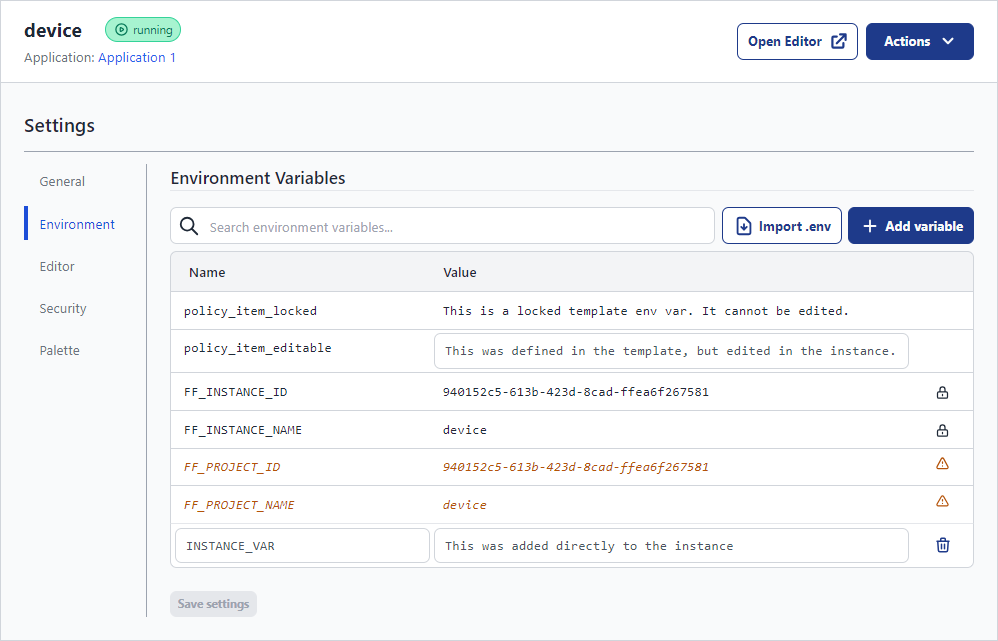- docs
- FlowFuse User Manuals
- Using FlowFuse
- Getting Started
- Static asset service
- Bill of Materials
- FlowFuse Concepts
- Changing the Stack
- Custom Hostnames
- Custom Node Packages
- Device Groups
- DevOps Pipelines
- Environment Variables
- FlowFuse Assistant
- FlowFuse File Nodes
- FlowFuse Project Nodes
- High Availability mode
- HTTP Access Tokens
- Instance Settings
- Logging
- persistent-context
- Shared Team Library
- Snapshots
- Team Broker
- Teams
- User Settings
- FlowFuse API
- Migrating a Node-RED project to FlowFuse
- Device Agent
- Device Agent
- FlowFuse Device Agent Introduction
- Quick Start
- Installation
- Register your Remote Instance
- Running the Agent
- Deploying your Flows
- Hardware Guides
- FlowFuse Cloud
- FlowFuse Cloud
- FlowFuse Self-Hosted
- Quick Start
- Installing FlowFuse
- Overview
- Configuring FlowFuse
- DNS Setup
- Docker install
- Docker from AWS Market Place
- Docker on Digital Ocean
- Add Project Stacks on Docker
- Docker Engine on Windows
- Email configuration
- First Run Setup
- FlowFuse File Storage
- Install FlowFuse on Kubernetes
- Upgrading FlowFuse
- Administering FlowFuse
- Administering FlowFuse
- Configuring Single Sign-On (SSO)
- Licensing
- Monitoring
- Telemetry
- User Management
- Support
- Community Support
- Premium Support
- Debugging Node-RED issues
- Contributing
- Contributing to FlowFuse
- Introduction
- Adding Template Settings
- API Design
- Creating debug stack containers
- Database migrations
- FlowFuse Architecture
- Local Install
- State Flows
- Device Editor
- Invite External Users
- User Login Flows
- Reset Password Flow
- Project Creation
- Instance states
- User Sign up Flow
- Team creation Flow
- Team Broker
- Working with Feature Flags
# Environment Variables
Environment Variables allow you to manage variables used in your Node-RED flows from the FlowFuse application, you can read more on how to access environment variables inside Node-RED in the Node-RED Docs.
An Environment Variable consists of a name and a value.
# Editing
You can edit the environment variables from the Settings tab of an instance, select the Environment option from the side menu.
Changes will only take effect when the Node-RED instance is restarted.
# Template provided variables
The Template may include some predefined environment variables that are automatically applied. The template may lock some of those variables to prevent an individual instance from changing them.
Variables provided by the template cannot be deleted, however if they are editable, their value can be set to blank.
# Node-RED instance variables
You can create additional variables for an individual Node-RED instance clicking the Add variable button.
You can import variables from a .env file using the Import .env button.
You can delete a variable using the trash can icon.
The image below shows an instance with the following environment variables:
policy_item_locked- added by the template, lockedpolicy_item_editable- added by the template, editableFF_INSTANCE_ID- provided by the platform, lockedFF_INSTANCE_NAME- provided by the platform, lockedFF_PROJECT_ID- provided by the platform, locked, depreciatedFF_PROJECT_NAME- provided by the platform, locked, depreciatedINSTANCE_VAR- added to the instance, editable

# Standard environment variables
Standard environment variables are set for all Node-RED instances running within the platform:
FF_INSTANCE_IDFF_INSTANCE_NAME
In addition, the following variables are set when running on a device:
FF_DEVICE_IDFF_DEVICE_NAMEFF_DEVICE_TYPEFF_SNAPSHOT_IDFF_SNAPSHOT_NAME
When deploying the same set of flows out to multiple devices, these variables can be used by the flows to identify the specific device being run on.
NOTE: FF_SNAPSHOT_NAME will not be immediately updated when the current snapshot is edited. It will only be updated when the snapshot is changed or a setting that causes the device to be restarted is changed.